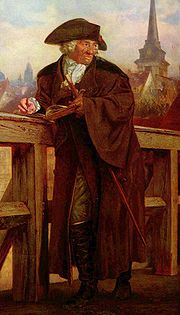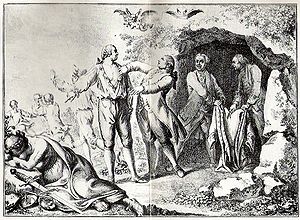
Daniel Chodowiecki
Encyclopedia

Poland
Poland , officially the Republic of Poland , is a country in Central Europe bordered by Germany to the west; the Czech Republic and Slovakia to the south; Ukraine, Belarus and Lithuania to the east; and the Baltic Sea and Kaliningrad Oblast, a Russian exclave, to the north...
- German
Germany
Germany , officially the Federal Republic of Germany , is a federal parliamentary republic in Europe. The country consists of 16 states while the capital and largest city is Berlin. Germany covers an area of 357,021 km2 and has a largely temperate seasonal climate...
painter and printmaker with Huguenot ancestry, who is most famous as an etcher. He spent most of his life in Berlin
Berlin
Berlin is the capital city of Germany and is one of the 16 states of Germany. With a population of 3.45 million people, Berlin is Germany's largest city. It is the second most populous city proper and the seventh most populous urban area in the European Union...
, and became the director of the Berlin Academy of Art.
Family
He was born in the city of Danzig (Gdańsk) in PolandPoland
Poland , officially the Republic of Poland , is a country in Central Europe bordered by Germany to the west; the Czech Republic and Slovakia to the south; Ukraine, Belarus and Lithuania to the east; and the Baltic Sea and Kaliningrad Oblast, a Russian exclave, to the north...
, and in a letter “in typical Berlin humor” wrote, “that he moved to Berlin, Germany, which shows for sure, that he is a 'genuine Pole'.” He kept close to the Huguenot
Huguenot
The Huguenots were members of the Protestant Reformed Church of France during the 16th and 17th centuries. Since the 17th century, people who formerly would have been called Huguenots have instead simply been called French Protestants, a title suggested by their German co-religionists, the...
scene, due to his ancestry. His grandfather Bartholomāus Chodowiecki had lived in the 16th century in Greater Poland
Greater Poland
Greater Poland or Great Poland, often known by its Polish name Wielkopolska is a historical region of west-central Poland. Its chief city is Poznań.The boundaries of Greater Poland have varied somewhat throughout history...
. Gottfried Chodowiecki, Daniel's father, was a tradesman in Danzig and his mother, Henriette Ayrer born in Switzerland
Switzerland
Switzerland name of one of the Swiss cantons. ; ; ; or ), in its full name the Swiss Confederation , is a federal republic consisting of 26 cantons, with Bern as the seat of the federal authorities. The country is situated in Western Europe,Or Central Europe depending on the definition....
, was a Huguenot. Daniel's grandfather Christian had been a tradesman in the city as well. When his father died, both Daniel (aged 16) and his younger brother Gottfried Chodowiecki went to live with their uncle in Berlin, who offered to educate them, and where Daniel received an artistic training with the painter Haid in Augsburg
Augsburg
Augsburg is a city in the south-west of Bavaria, Germany. It is a university town and home of the Regierungsbezirk Schwaben and the Bezirk Schwaben. Augsburg is an urban district and home to the institutions of the Landkreis Augsburg. It is, as of 2008, the third-largest city in Bavaria with a...
. His brother also became a painter.
Art
Soon Daniel was able to earn a living by painting. He was admitted to the Berlin Academy in 1764 and became vice-director under Bernhard RodeBernhard Rode
Bernhard Rode was a Prussian artist and engraver well-known for portraying historical scenes and allegorical works. He knew most of the central figures in the Berlin Enlightenment as Friedrich Nicolai and Gotthold Lessing, and the philosophical and political discussions of the Berlin Philosophs...
in 1788. He had found his true calling and became the most famous German graphic artist of his time. His works includes several thousand etching
Etching
Etching is the process of using strong acid or mordant to cut into the unprotected parts of a metal surface to create a design in intaglio in the metal...
s, usually rather small, and many drawings and paintings. His book illustrations embrace almost all the great classics. His prints represent in great detail the life of the bourgeoisie during the Zopfstil period, a time between Rococo
Rococo
Rococo , also referred to as "Late Baroque", is an 18th-century style which developed as Baroque artists gave up their symmetry and became increasingly ornate, florid, and playful...
and Classicism
Classicism
Classicism, in the arts, refers generally to a high regard for classical antiquity, as setting standards for taste which the classicists seek to emulate. The art of classicism typically seeks to be formal and restrained: of the Discobolus Sir Kenneth Clark observed, "if we object to his restraint...
. In 1797 Chodowiecki was appointed director of the Academy of Arts in Berlin, where he died on 7 February 1801. The bulk of his work was in illustrating scientific books by Basedow
Johann Bernhard Basedow
Johann Bernhard Basedow was a German educational reformer, teacher and writer. He founded the Philanthropinum, a short-lived but influential progressive school in Dessau, and was the author of "Elementarwerk", a popular illustrated textbook for children.-Early years:Basedow was born in Hamburg,...
, Buffon, Lavater, Pestalozzi
Pestalozzi
Pestalozzi may refer to:* Johann Heinrich Pestalozzi * Hans A. Pestalozzi Schools with that name:* Colegio Pestalozzi, Argentina* Pestalozzi-Gymnasium Biberach, Germany* Kinderdorf Pestalozzi, Switzerland...
and others. He also painted many portraits of Polish gentry and was interested in Huguenot and Polish history as well, making some paintings on the topic.
He was in tune with the developing spirit of the age, and many works reflect the cult of sensibility
Sensibility
Sensibility refers to an acute perception of or responsiveness toward something, such as the emotions of another. This concept emerged in eighteenth-century Britain, and was closely associated with studies of sense perception as the means through which knowledge is gathered...
, and then the revolutionary and German nationalist
Nationalism
Nationalism is a political ideology that involves a strong identification of a group of individuals with a political entity defined in national terms, i.e. a nation. In the 'modernist' image of the nation, it is nationalism that creates national identity. There are various definitions for what...
feelings of the end of the century.
In printmaking
Printmaking
Printmaking is the process of making artworks by printing, normally on paper. Printmaking normally covers only the process of creating prints with an element of originality, rather than just being a photographic reproduction of a painting. Except in the case of monotyping, the process is capable...
, he is credited with the invention of the deliberate remarque, a small sketch on a plate, lying outside the main image. These were originally little sketches or doodles by artists, not really meant to be seen, but Chodowiecki turned them into "bonus items" for collectors.

Partitions of Poland
The Partitions of Poland or Partitions of the Polish–Lithuanian Commonwealth took place in the second half of the 18th century and ended the existence of the Polish–Lithuanian Commonwealth, resulting in the elimination of sovereign Poland for 123 years...
Chodowiecki wrote to Gräfin Solms-Laubach: "From father's side I'm Polish, a descendant of a brave nation which will soon vanish". In a letter to Józef Łęcki, the Polish astronomer, he wrote: "I consider it an honour to be a genuine Pole, even though I am now living in Germany". Because of his mother's and his wife's Huguenot descent he was very close to the Huguenots of Berlin. Nearly all his life and career was spent in Germany, writing in German and living in Berlin from the age of almost 17.
One of his most popular books is "Journey from Berlin to Danzig" with many illustrations. He purchased a horse rather than going by stage coach. This was his first return after 30 years absence and he went specifically to see his elderly mother and sisters in Danzig again. He made only one more trip to Danzig afterwards, to his mother's funeral. He describes and illustrates towns and people in Pomerania and Prussia on the way.
Chodowiecki is buried at the Französischer Friedhof cemetery in Berlin.

